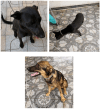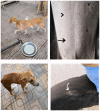ORNIPURAL® as conventional therapy versus mixture of Curcuma longa extract and pomegranate peel extract as homeotherapy in dogs with dexamethasone-induced hepatopathy: clinicolaboratory, ultrasonographic, and histopathological monitoring
- PMID: 40271488
- PMCID: PMC12016885
- DOI: 10.3389/fvets.2025.1564648
ORNIPURAL® as conventional therapy versus mixture of Curcuma longa extract and pomegranate peel extract as homeotherapy in dogs with dexamethasone-induced hepatopathy: clinicolaboratory, ultrasonographic, and histopathological monitoring
Abstract
Introduction: Curcuma longa extract and pomegranate peel extract as homeotherapy have numerous therapeutic uses, mainly for anti-inflammatory, immunomodulatory, and hepatoprotective efficacy. The current study compared ORNIPURAL® (as a commercial hepatoprotective drug) and a herbal mixture of Curcuma longa extract and pomegranate peel extract [as homeotherapy] in dogs with dexamethasone-induced hepatopathy throughout a 42-day long-term study.
Methods: The study was conducted on mongrel dogs (n = 30) throughout three phases of the experiment: an acclimatization phase (14 days), a steroidal-induced hepatopathy phase (14 days), and a treatment phase (14 days, i.e., either with ORNIPURAL® or with herbal mixtures). The investigated dogs undergoing complete clinical and ultrasonographic examinations as well as hematological analysis and serum hepatorenal biomarkers that were estimated in days 0 (control group), 7 (hepatopathy group), 14 (hepatopathy group), 21 (treatment group), and 28 (treatment group). Histopathology of the liver was conducted for some dogs on days 0, 14, and 28 after the euthanization of these animals.
Results and conclusion: The present study reported the most remarkable efficacy of both ORNIPURAL® and a herbal mixture of Curcuma longa extract and pomegranate peel extract as hepatoprotective medicaments in the therapy of dexamethasone-induced fatty liver in dogs. Therefore, a 14-day treatment with either a herbal mixture or ORNIPURAL® in treated dogs (treatment groups) induced an unmistakable improvement in their clinical status, blood pictures, and serum hepatorenal parameters as well as characteristic sonographic and histopathological findings compared with those in dexamethasone-induced hepatic lipidosis (hepatopathy groups). Compared to dogs treated with ORNIPURAL®, this clinical improvement was more evident in dogs treated with an herbal mixture. Moreover, no significant alterations in blood pictures and serum hepatorenal indices were demonstrated between ORNIPURAL® and herbal-treated dogs. Overall, the herbal mix of Curcuma longa extract and pomegranate peel extract had higher efficacy and greater potency than conventional therapy that uses ORNIPURAL® in treating dogs with hepatopathy. The study also recommended the parallel use of this herbal mixture as well as ORNIPURAL® in long-term therapeutic strategies in dogs with dexamethasone-induced fatty liver as both minimized dexamethasone side effects. Ultrasonography alone was not enough to evaluate hepatobiliary disorders in canines.
Keywords: Curcuma longa extract; ORNIPURAL®; dogs; liver histopathology; pomegranate peel extract; steroidal hepatopathy; ultrasonography.
Copyright © 2025 Khalphallah, Mousa, Almuhanna, Hassan, Al-Shuraym, Alkeridis, Abdel-lah, Shukry, Abdelhafez and Elmeligy.
Conflict of interest statement
The authors declare that the research was conducted in the absence of any commercial or financial relationships that could be construed as a potential conflict of interest.
Figures


















Similar articles
-
Pomegranate peel extract, N-Acetylcysteine and their combination with Ornipural alleviate Cadmium-induced toxicity in rats.J Vet Med Sci. 2023 Sep 7;85(9):990-997. doi: 10.1292/jvms.22-0375. Epub 2023 Jul 26. J Vet Med Sci. 2023. PMID: 37495528 Free PMC article.
-
Ornipural® Mitigates Malathion-Induced Hepato-Renal Damage in Rats via Amelioration of Oxidative Stress Biomarkers, Restoration of Antioxidant Activity, and Attenuation of Inflammatory Response.Antioxidants (Basel). 2022 Apr 11;11(4):757. doi: 10.3390/antiox11040757. Antioxidants (Basel). 2022. PMID: 35453442 Free PMC article.
-
Curcuma longa and Trigonella foenum graecum-enriched nutrient mixture from germinated Macrotyloma uniflorum and Vigna radiate ameliorate nonalcoholic fatty liver diseases in rats.J Food Biochem. 2020 Apr;44(4):e13159. doi: 10.1111/jfbc.13159. Epub 2020 Feb 3. J Food Biochem. 2020. PMID: 32017151
-
Preclinical Evidence of Curcuma longa and Its Noncurcuminoid Constituents against Hepatobiliary Diseases: A Review.Evid Based Complement Alternat Med. 2020 Jul 28;2020:8761435. doi: 10.1155/2020/8761435. eCollection 2020. Evid Based Complement Alternat Med. 2020. PMID: 32802138 Free PMC article. Review.
-
The efficacy and safety of Curcuma longa extract and curcumin supplements on osteoarthritis: a systematic review and meta-analysis.Biosci Rep. 2021 Jun 25;41(6):BSR20210817. doi: 10.1042/BSR20210817. Biosci Rep. 2021. PMID: 34017975 Free PMC article.
References
-
- Rothuizen J. Hepatitis in dogs. In: Weber O, Protzer U, (editors). Comparative hepatitis. Birkhäuser Advances in Infectious Diseases. Switzerland: Basel, Birkhäuser Basel (2008).
-
- Fieten H, Hooijer-Nouwens BD, Biourge VC, Leegwater PA, Watson AL, van den Ingh TSGAM, et al. . Association of dietary copper and zinc levels with hepatic copper and zinc concentration in Labrador retrievers. J Vet Intern Med. (2012) 26:1274–80. doi: 10.1111/j.1939-1676.2012.01001.x, PMID: - DOI - PubMed
LinkOut - more resources
Full Text Sources

